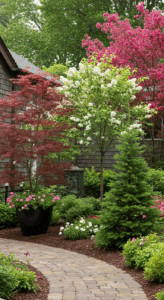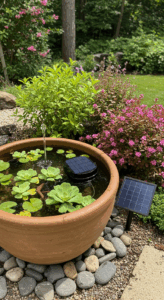1. Stone Slab Serenity: Crafting a Rustic Pathway
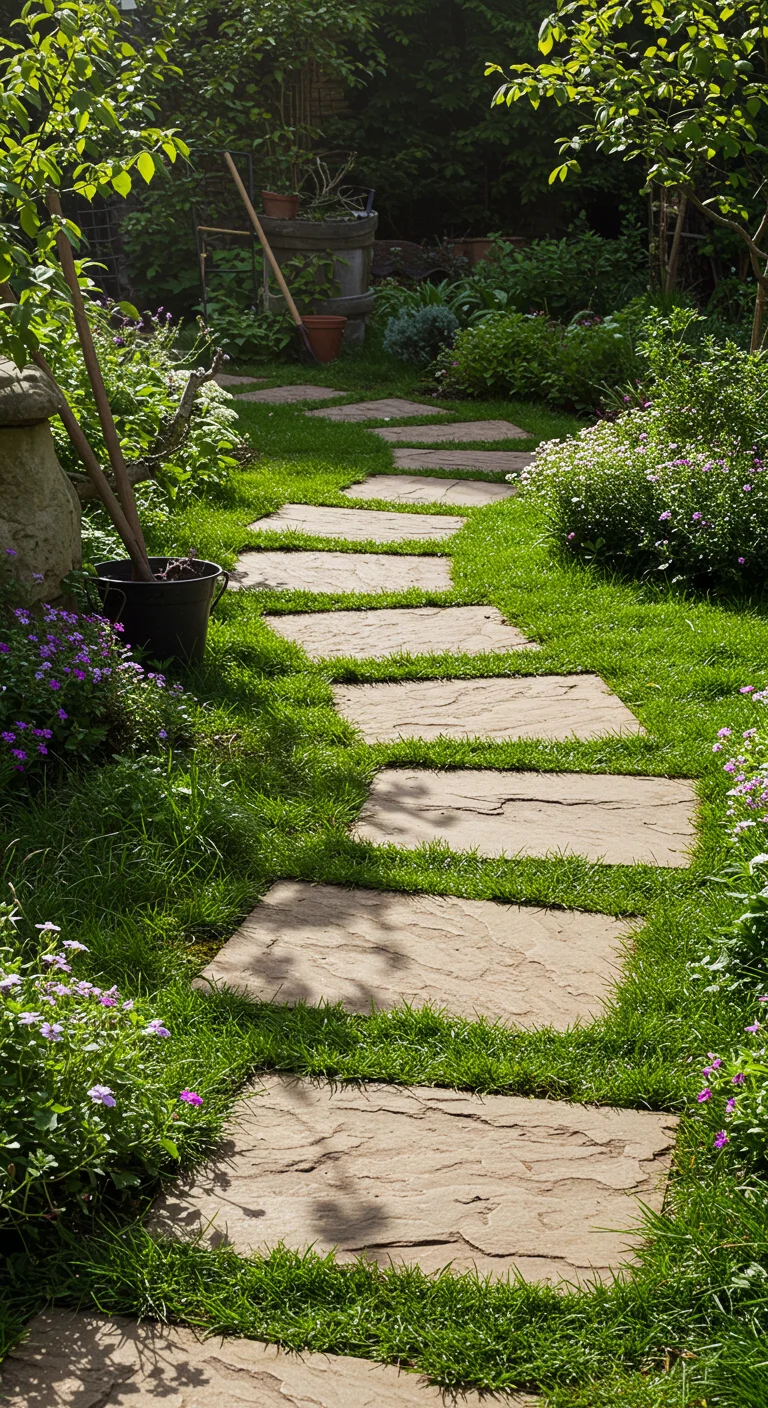
Creating a rustic pathway with stone slabs not only enhances the aesthetics of your garden but also offers a durable and functional solution for foot traffic. Start by selecting natural stone slabs that complement your garden’s style, ensuring they are thick enough to withstand weather conditions. Lay out the stones in a pattern that suits your taste, leaving small gaps for grass or moss to grow, which adds to the rustic charm. To secure the stones, dig shallow trenches, place a layer of sand or gravel for drainage, and then set the slabs in place. This method not only provides a stable surface but also encourages plant life to flourish in between the stones, creating a harmonious blend of nature and design. Regular maintenance, such as clearing debris and checking for shifting stones, will keep your pathway looking pristine for years to come.
2. Gravel Glam: The Allure of Natural Textures
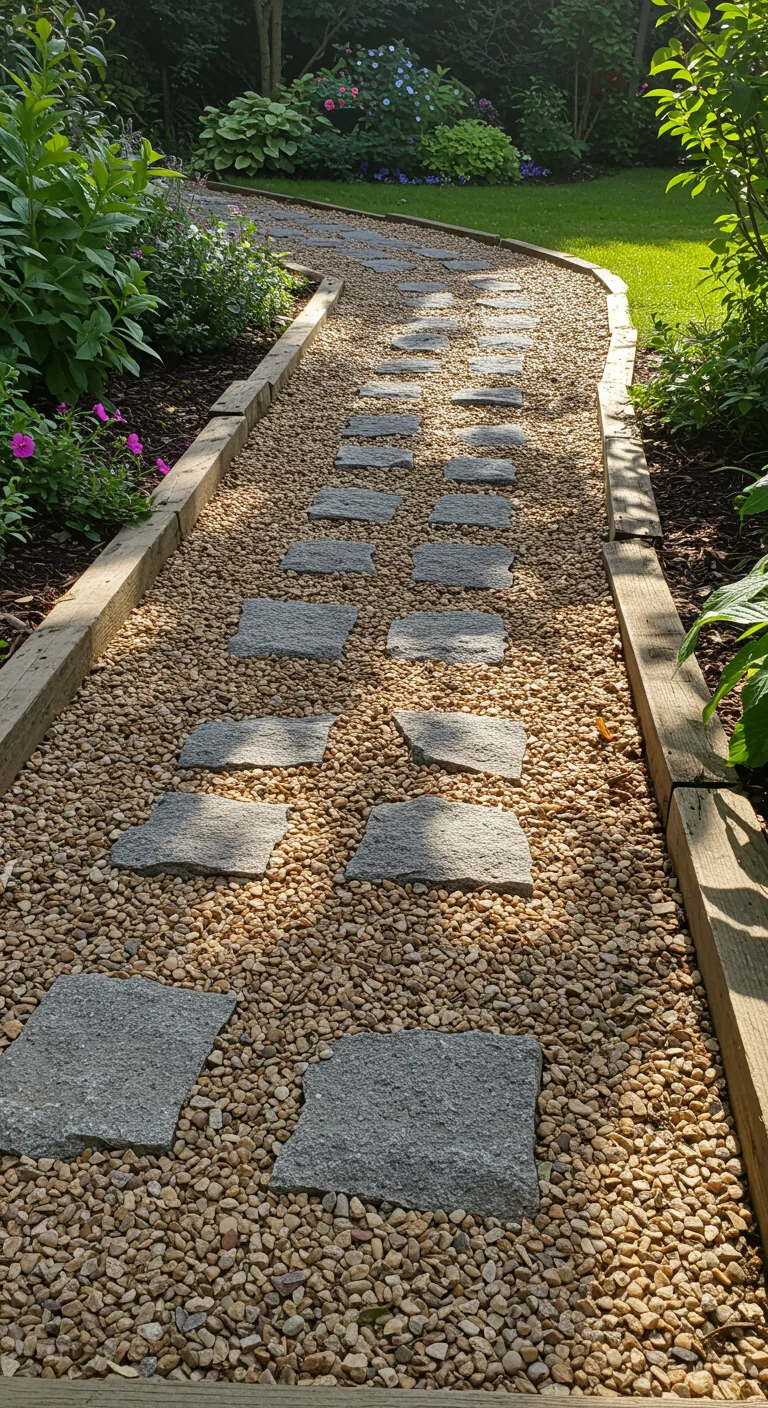
Gravel paths bring a rustic charm to any garden, seamlessly blending with natural surroundings while offering functional beauty. The allure of natural textures lies in their versatility; you can choose from various types of gravel—from smooth pebbles to angular stones—allowing you to customize the look to match your garden’s aesthetic. Not only do gravel paths provide excellent drainage, reducing puddles and mud, but they are also easy to install and maintain. Simply define the path’s edges with timber or stone borders, lay down a weed barrier, and fill with your chosen gravel. The gentle crunch underfoot and the organic feel of gravel create an inviting atmosphere, making it ideal for garden strolls or as a practical walkway to connect different areas of your outdoor space.
3. Brick by Brick: Timeless Elegance in Your Garden
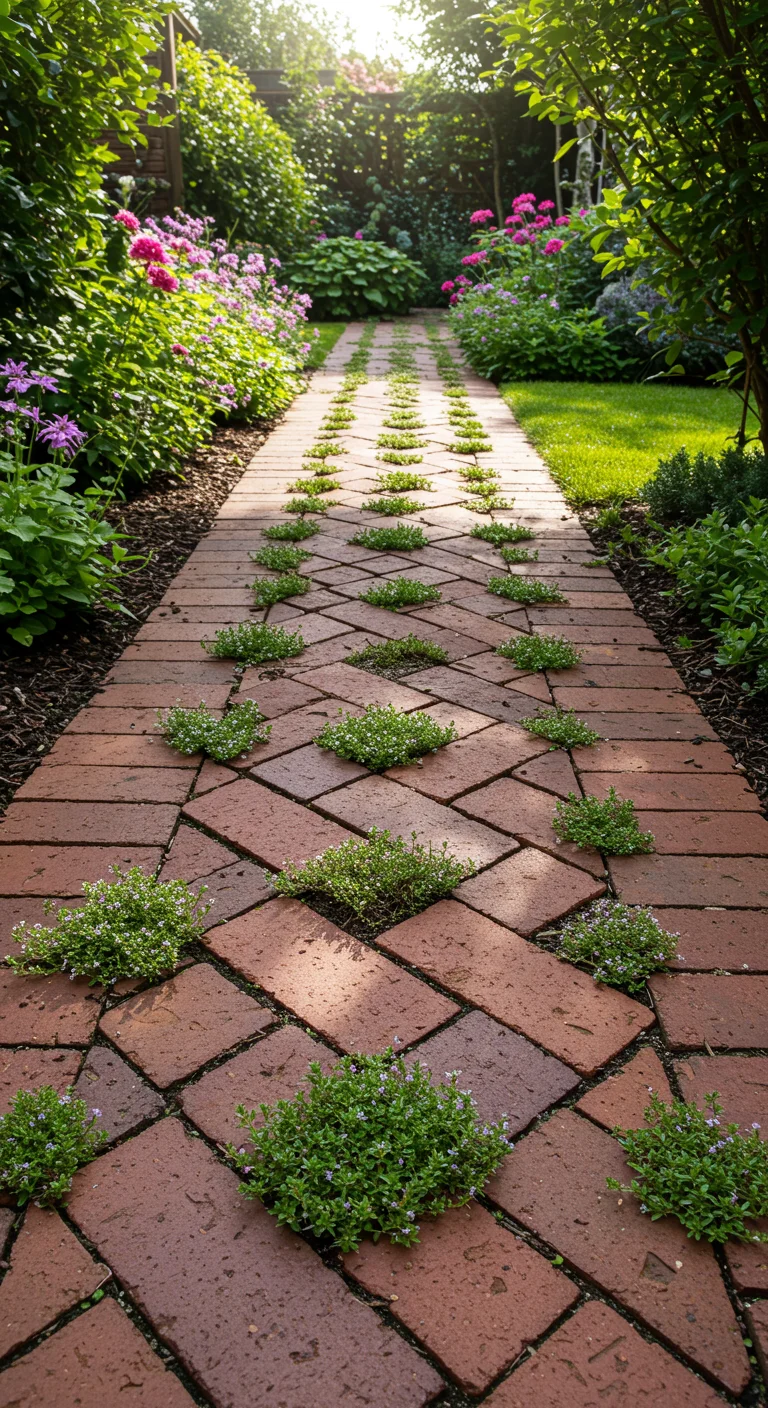
Creating a brick pathway in your garden not only enhances its aesthetic appeal but also adds a touch of timeless elegance. Begin by selecting high-quality bricks that complement your garden’s theme, whether rustic or modern. Ensure you prepare a solid foundation by excavating the area to a depth of around 6 inches and filling it with gravel for proper drainage. Lay the bricks in a pattern that suits your style—herringbone or running bond are popular choices. For added charm, consider planting creeping thyme or moss in between the bricks, which will soften the pathway and provide a natural look. Regular maintenance involves keeping the joints clear of weeds and applying a sealant to enhance the bricks’ durability and color, ensuring your garden path remains a stunning focal point for years to come.
4. Mosaic Masterpieces: Artful Path Designs
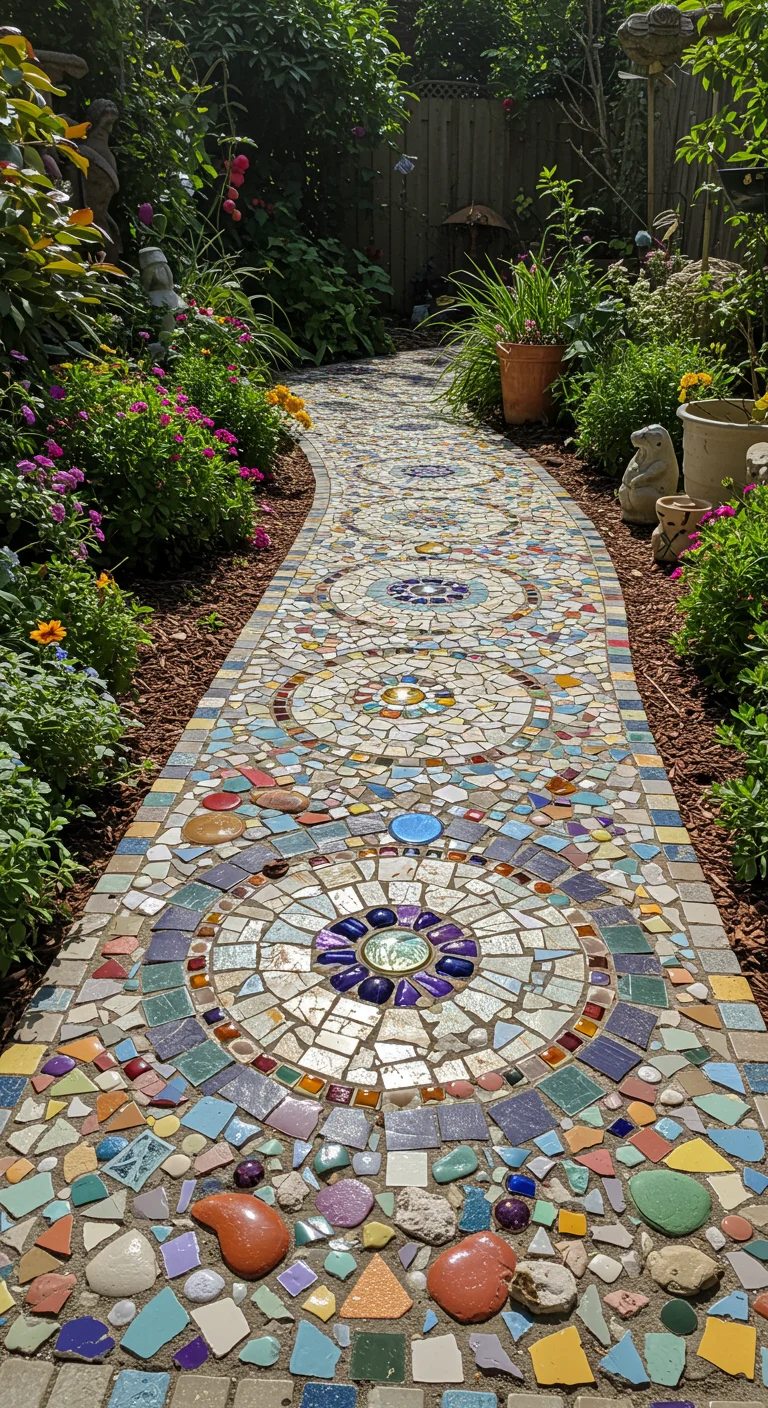
Mosaic masterpieces can transform any garden path into an eye-catching focal point. By combining various materials such as colorful tiles, stones, and glass, you can create intricate designs that reflect your personality and style. Start by sketching your desired pattern on paper before laying out the materials on the ground. Use a strong adhesive to secure the pieces in place, and fill in any gaps with grout for a polished finish. Consider incorporating natural elements like pebbles or seashells to enhance the visual appeal. This DIY project not only beautifies your garden but also allows for endless creativity, making it a rewarding endeavor for both novice and experienced gardeners alike.
5. Whimsical Wood: Embracing Nature with Timber Walkways
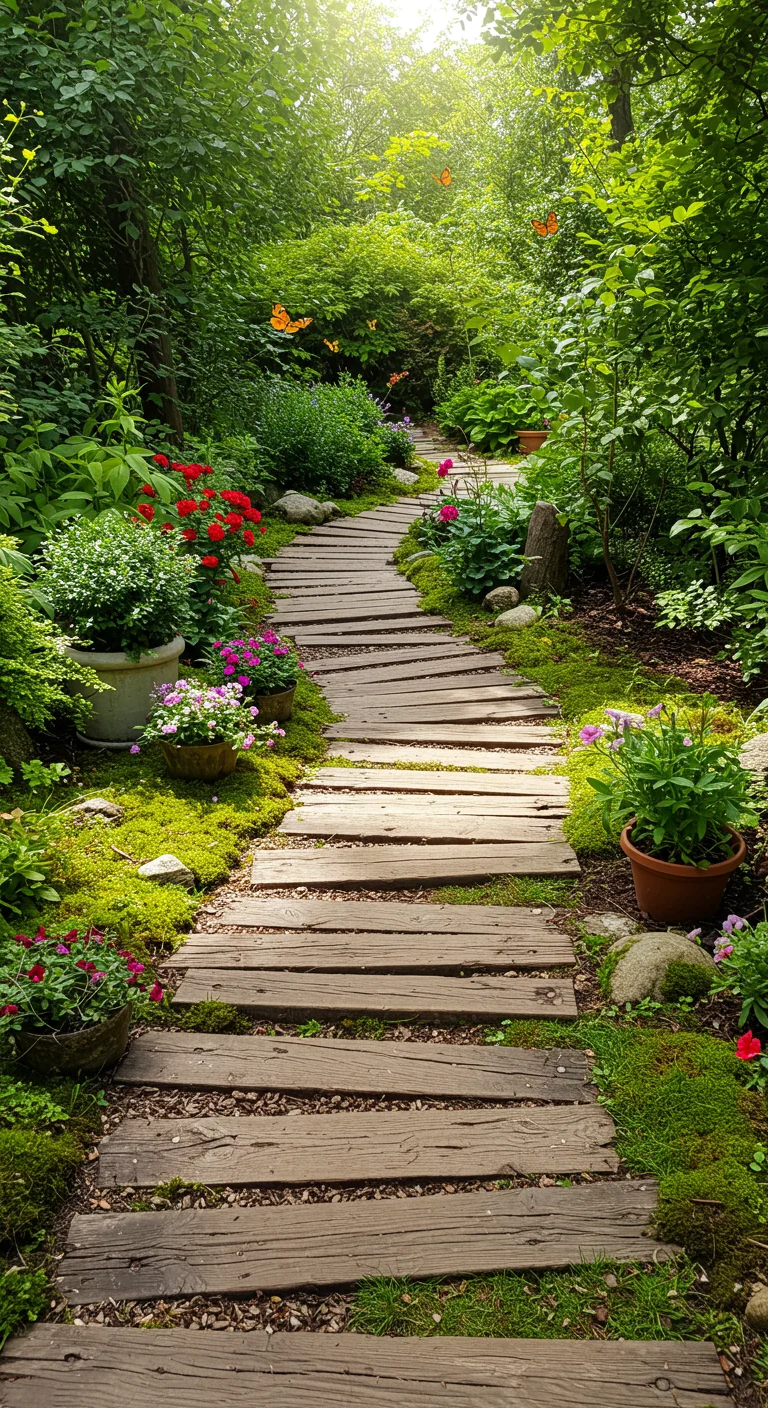
Whimsical wood walkways are a charming way to connect different areas of your garden while embracing the natural beauty around you. Constructing these paths using timber not only adds an organic aesthetic but also provides a sturdy and eco-friendly option for navigating your outdoor space. Opt for untreated cedar or redwood, known for their durability and resistance to rot, and consider varying the width and spacing of your planks for a playful look. Incorporate curvy designs that mimic the organic lines of nature, and don’t hesitate to add decorative elements like moss or small potted plants along the edges for a touch of greenery. Finish the walkway with a natural sealant to enhance the wood’s longevity, ensuring your whimsical path remains a delightful feature for years to come.
6. Colorful Concrete: Adding Personality to Your Path
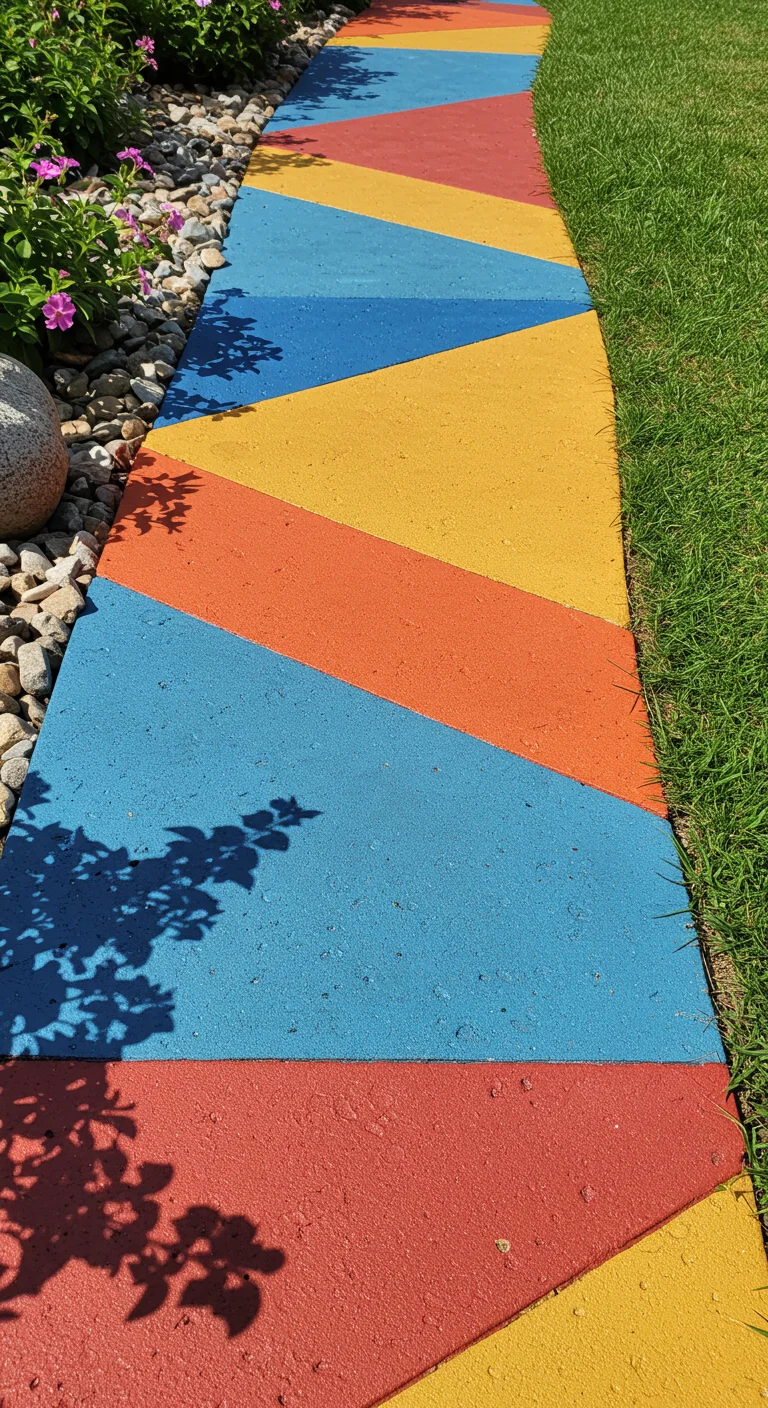
Colorful concrete can transform a mundane garden path into a vibrant focal point, adding personality and style to your outdoor space. By using concrete dyes, pigments, or even stencils, you can create intricate patterns and a spectrum of colors that reflect your personal taste. Consider mixing different colors for a mosaic effect or using a single bold hue to make a statement. Additionally, incorporating textures through stamping or etching can further enhance the visual appeal. This DIY project not only allows for customization but also provides durability and low maintenance, making it a practical choice for gardeners looking to infuse creativity into their landscapes. Remember to seal your colored concrete to maintain its vibrancy against the elements over time.
7. Eco-Friendly Pavers: Sustainable Garden Path Ideas
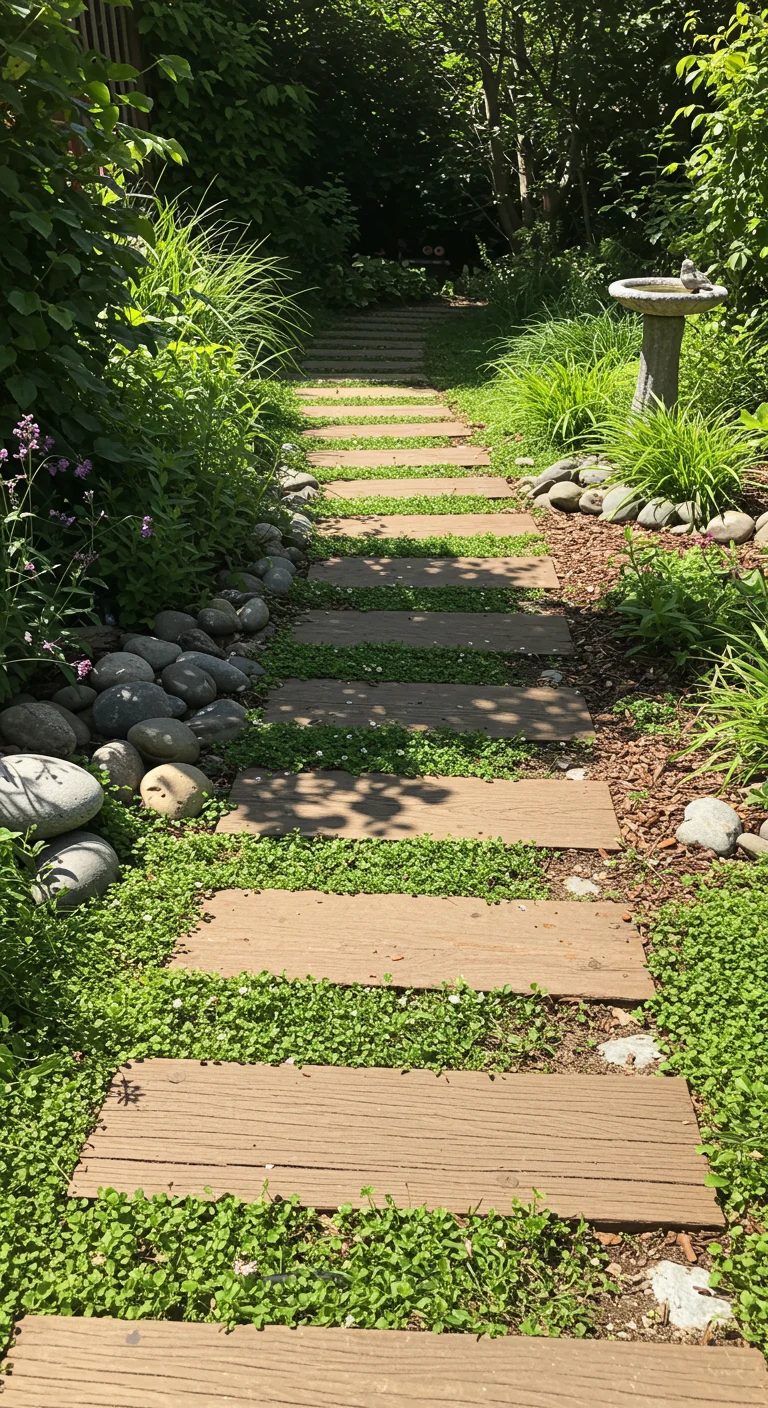
Eco-friendly pavers are an excellent choice for creating sustainable garden paths that blend seamlessly with nature. Options such as reclaimed wood, natural stone, and permeable concrete not only reduce environmental impact but also enhance the aesthetic appeal of your outdoor space. Consider using locally sourced materials to decrease your carbon footprint, or opt for pavers made from recycled materials, which are both durable and eco-conscious. Planting ground cover or filling the gaps between pavers with native grasses can promote biodiversity while preventing soil erosion. Additionally, incorporating permeable materials allows water to naturally filter through, reducing runoff and improving drainage. By choosing eco-friendly pavers, you can achieve a beautiful garden path that respects and nurtures the environment.
8. Shell Shocked: Coastal-Inspired Pathways
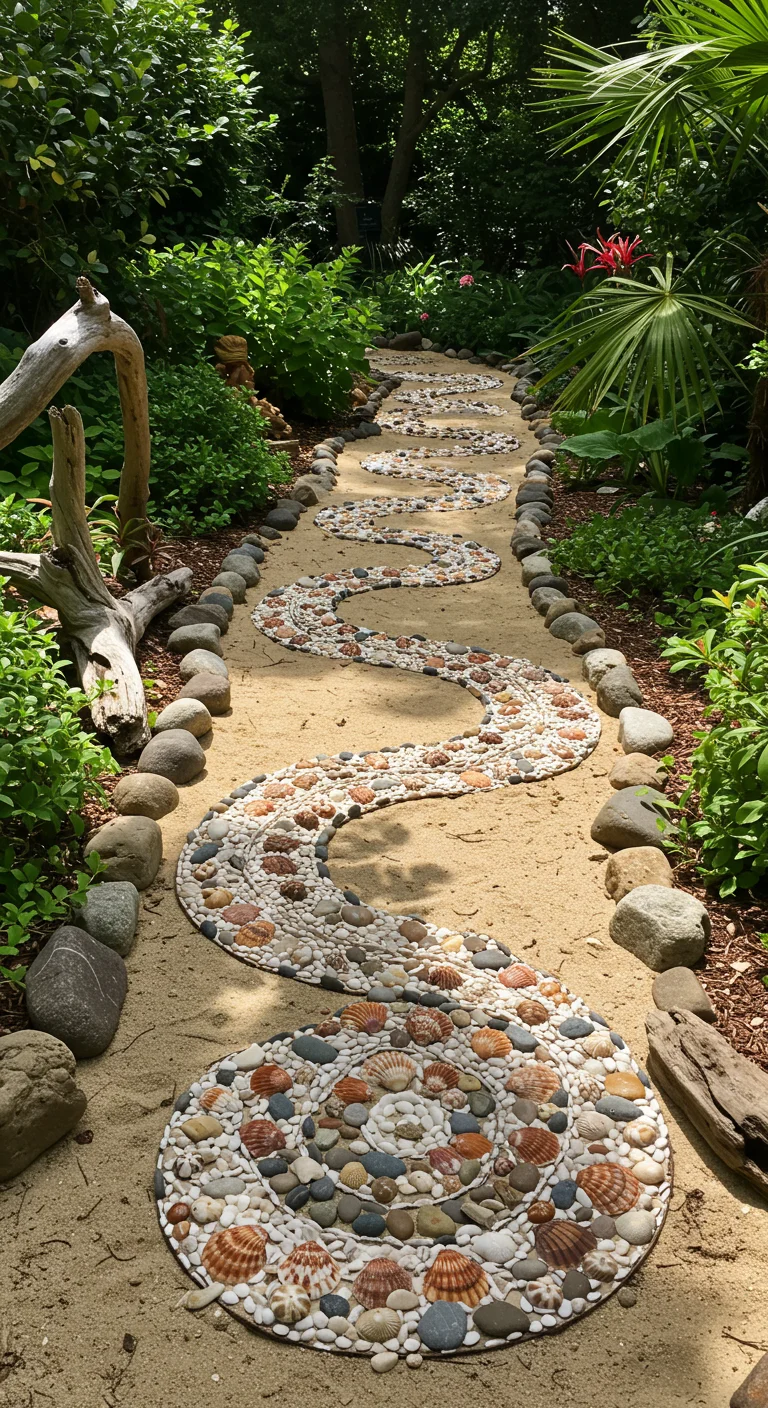
Transform your garden into a coastal paradise with Shell Shocked pathways that blend functionality and aesthetic appeal. Start by collecting various seashells and pebbles to create a stunning mosaic effect along the path. Lay down a base of sand or gravel to mimic a beachy feel and ensure proper drainage. Arrange the shells in patterns, such as concentric circles or flowing lines, to guide visitors through your garden. Consider incorporating driftwood or beach stones as edging to enhance the coastal theme. This DIY project not only adds beauty but also invites a touch of the shoreline into your outdoor space, making it an ideal retreat for relaxation or entertaining guests.
9. Pebble Perfection: Minimalist Garden Paths
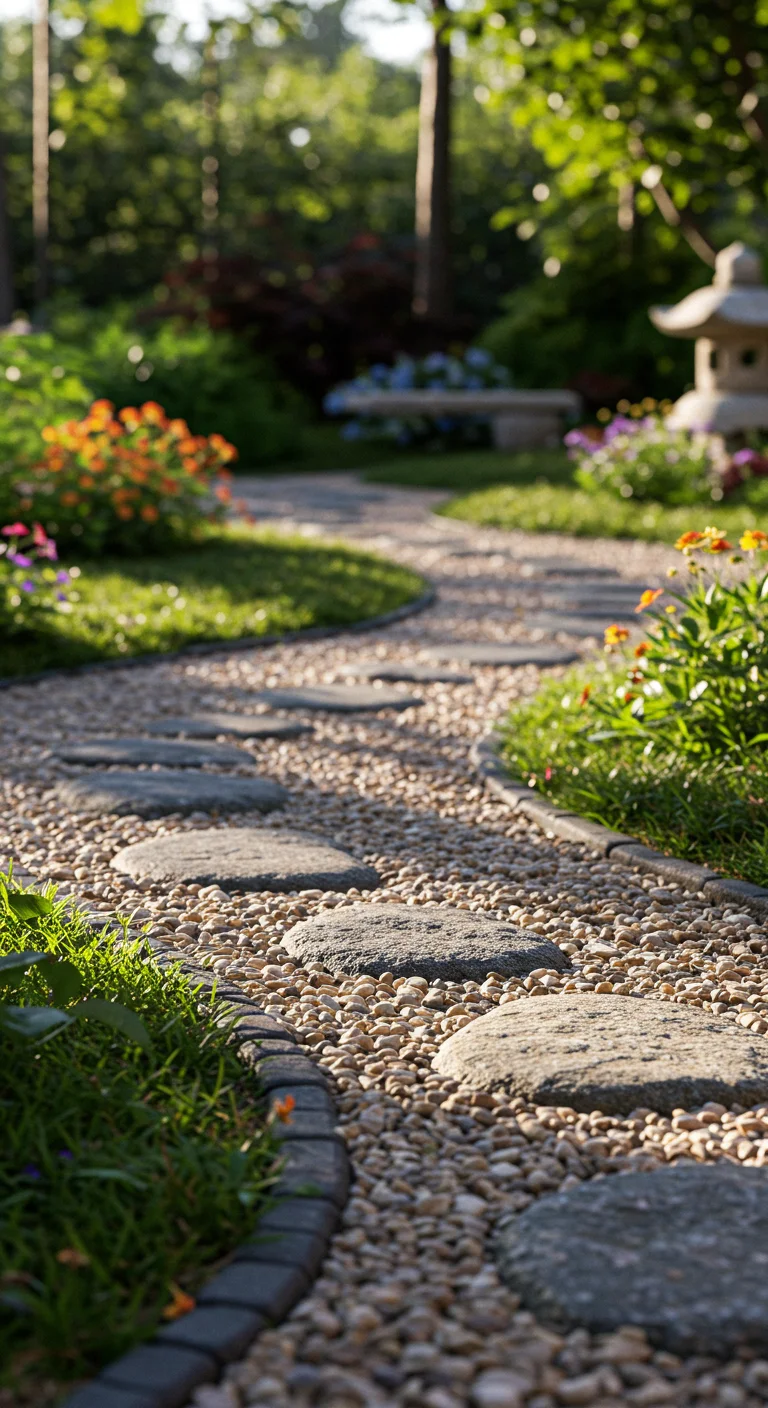
Pebble perfection in minimalist garden paths offers a serene and modern touch to outdoor spaces while being easy to install and maintain. By using smooth, rounded pebbles, you can create a natural-looking path that blends seamlessly with your garden’s landscape. To design your pebble path, start by defining the shape with stakes and string, then excavate the area to a depth of about three inches. Lay down landscaping fabric to prevent weeds, followed by a layer of crushed stone for drainage, before finally filling the path with your chosen pebbles. This technique not only provides a durable surface for walking but also enhances the aesthetic appeal of your garden, allowing for a clean and uncluttered look that showcases your plants and flowers beautifully.
10. Flagstone Fantasy: Creating a Natural Look
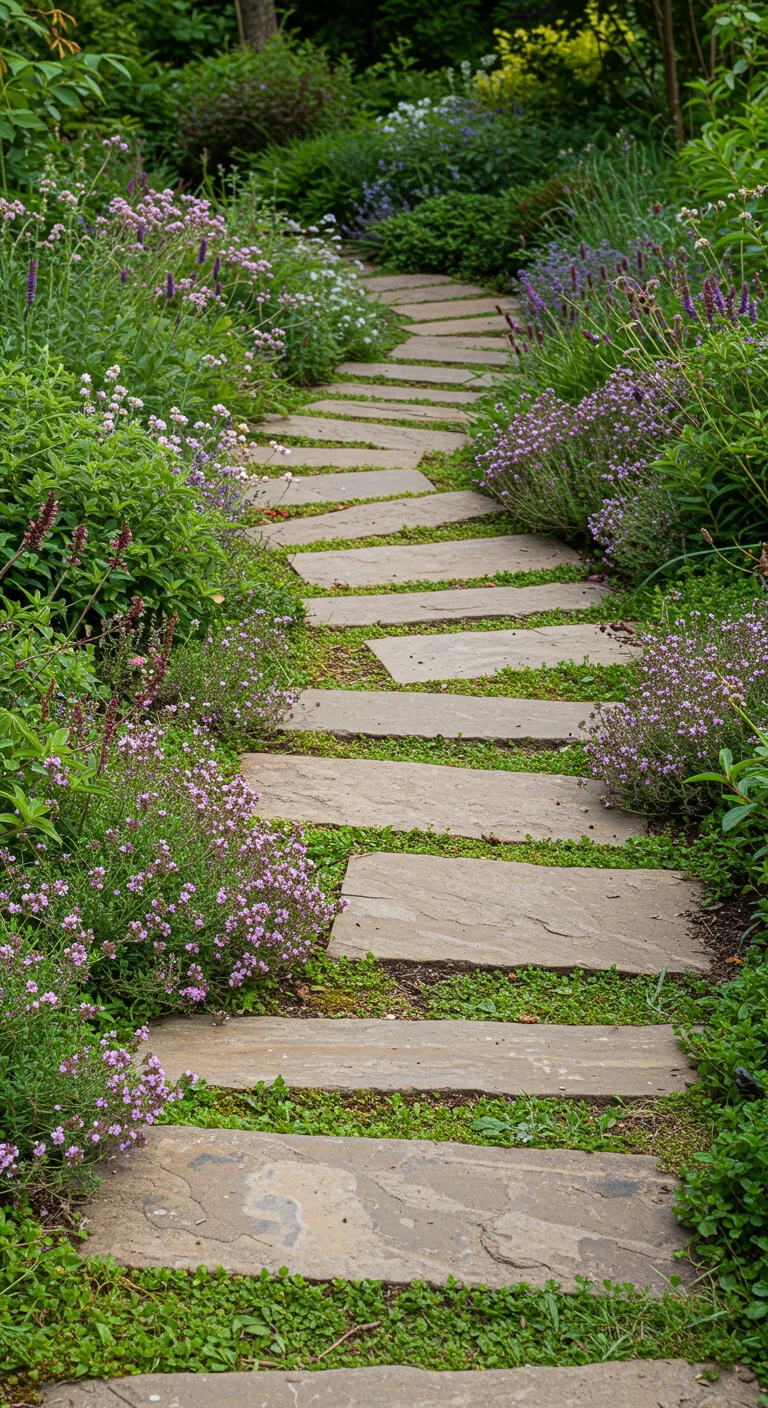
Creating a natural look with flagstone paths can enhance the beauty of your garden while providing a sturdy walkway. Begin by selecting irregularly shaped flagstones that blend seamlessly with your landscape. Lay the stones in a random pattern, leaving small gaps that can be filled with soil, gravel, or creeping plants like thyme or moss for a lush, organic feel. Ensure the stones are set slightly unevenly to mimic the natural terrain and use a level to maintain stability. To further integrate your path into the surrounding environment, consider planting native flowers or low shrubs along the edges. This not only softens the appearance of hardscaping but also invites pollinators to your garden, creating a vibrant ecosystem for you to enjoy.
11. Recycled Treasures: Upcycling for Unique Paths
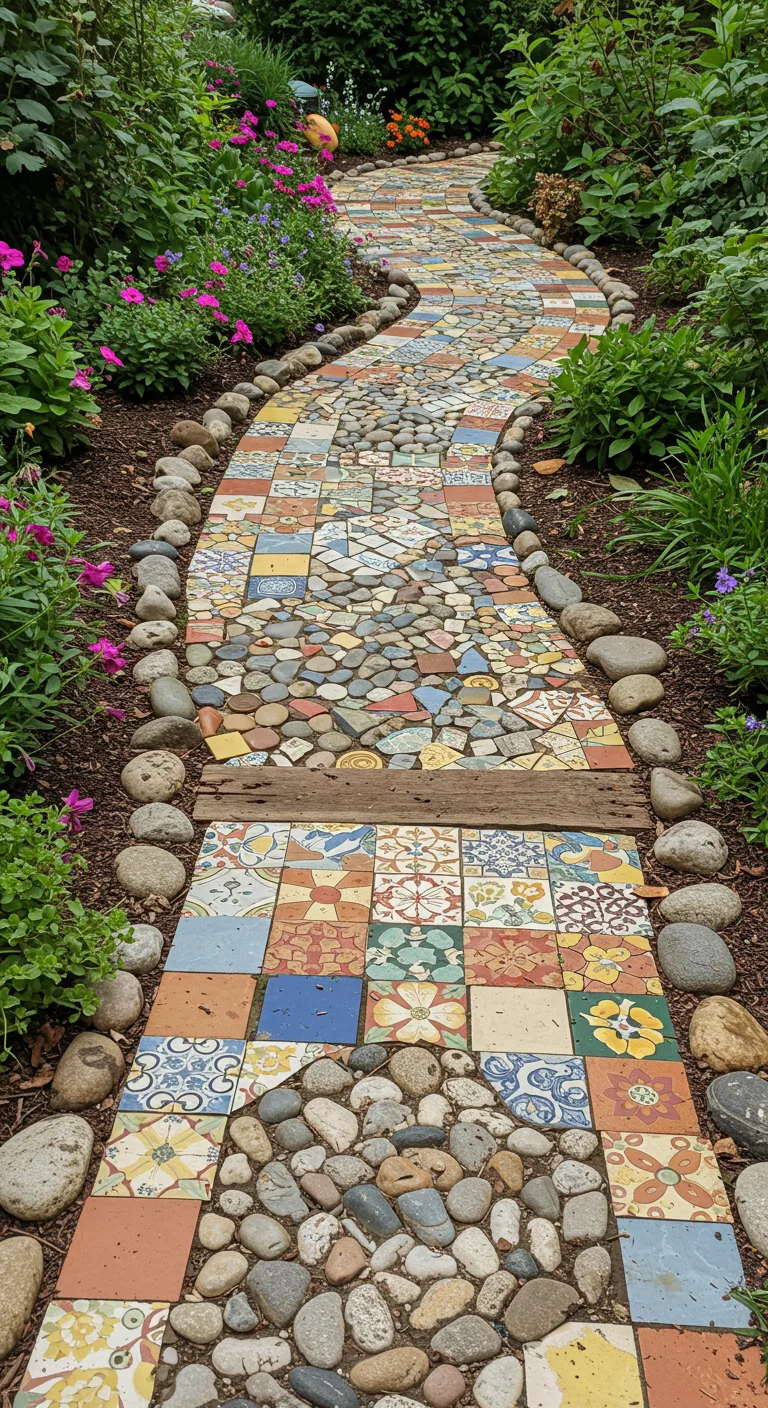
Upcycling is an innovative and eco-friendly way to create unique garden paths while reducing waste. Start by collecting materials like old bricks, wood pallets, or broken tiles that can be reimagined into functional art. For instance, you can break tiles into mosaic pieces and arrange them in an eye-catching pattern for a colorful walkway. Alternatively, wooden pallets can be disassembled and laid flat to form rustic, textured pathways. Consider incorporating natural elements like stones or gravel to fill gaps between upcycled materials, enhancing both stability and drainage. This approach not only adds character to your garden but also encourages sustainability by giving new life to discarded items, making your outdoor space truly one-of-a-kind.
12. Zen Sand Paths: Finding Tranquility in the Garden
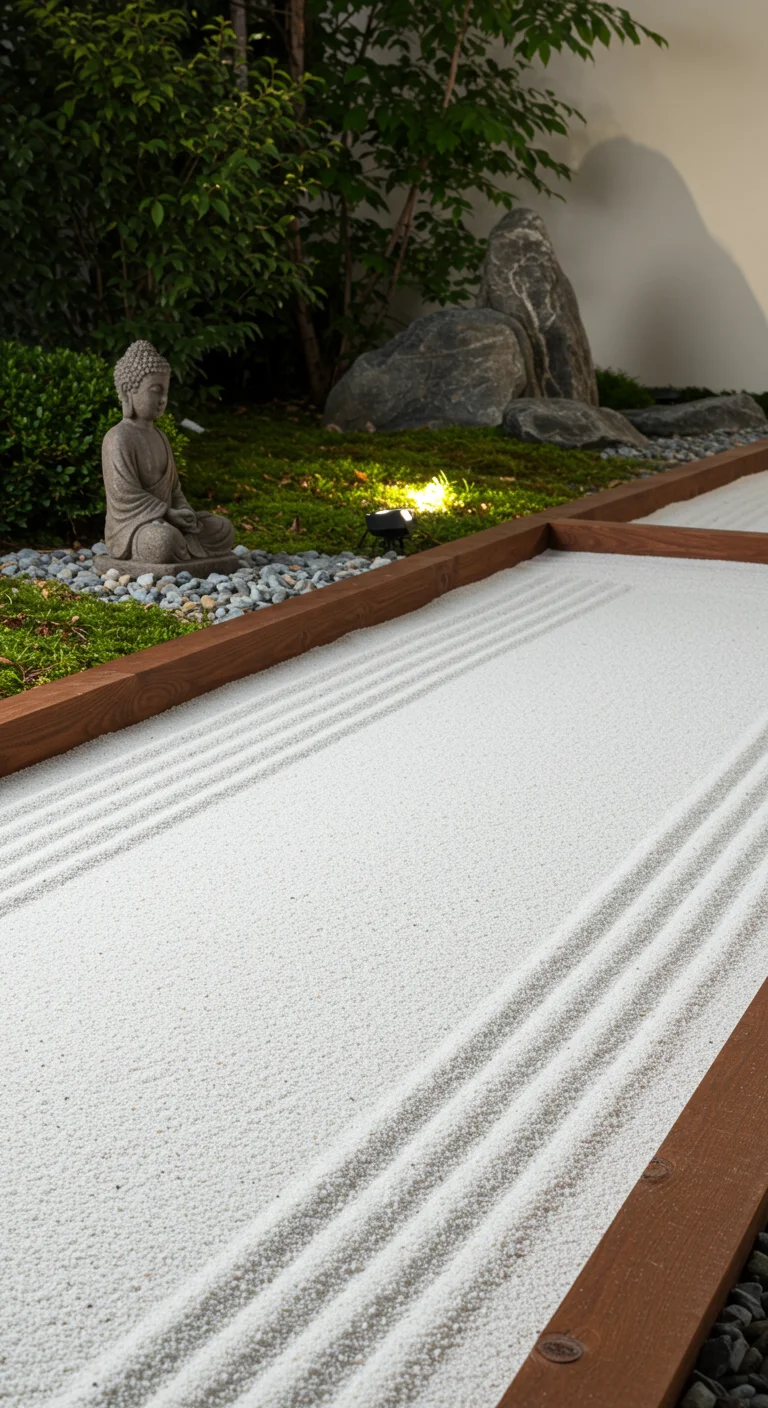
Zen sand paths are a serene addition to any garden, fostering tranquility and mindfulness. To create a Zen sand path, begin by selecting a peaceful location in your garden that invites reflection. Clear the area of grass and weeds, and lay down a landscape fabric to prevent unwanted growth. Then, frame your path with natural stones or wooden borders to define its edges. Fill the path with fine, white sand or gravel, which can be raked into soothing patterns. Incorporate carefully placed rocks or minimalist sculptures to enhance the Zen aesthetic. Regularly raking the sand can provide a meditative practice, while the simplicity of the path encourages quiet contemplation amidst the beauty of nature.
13. Pathway Planting: Integrating Flora and Walkways
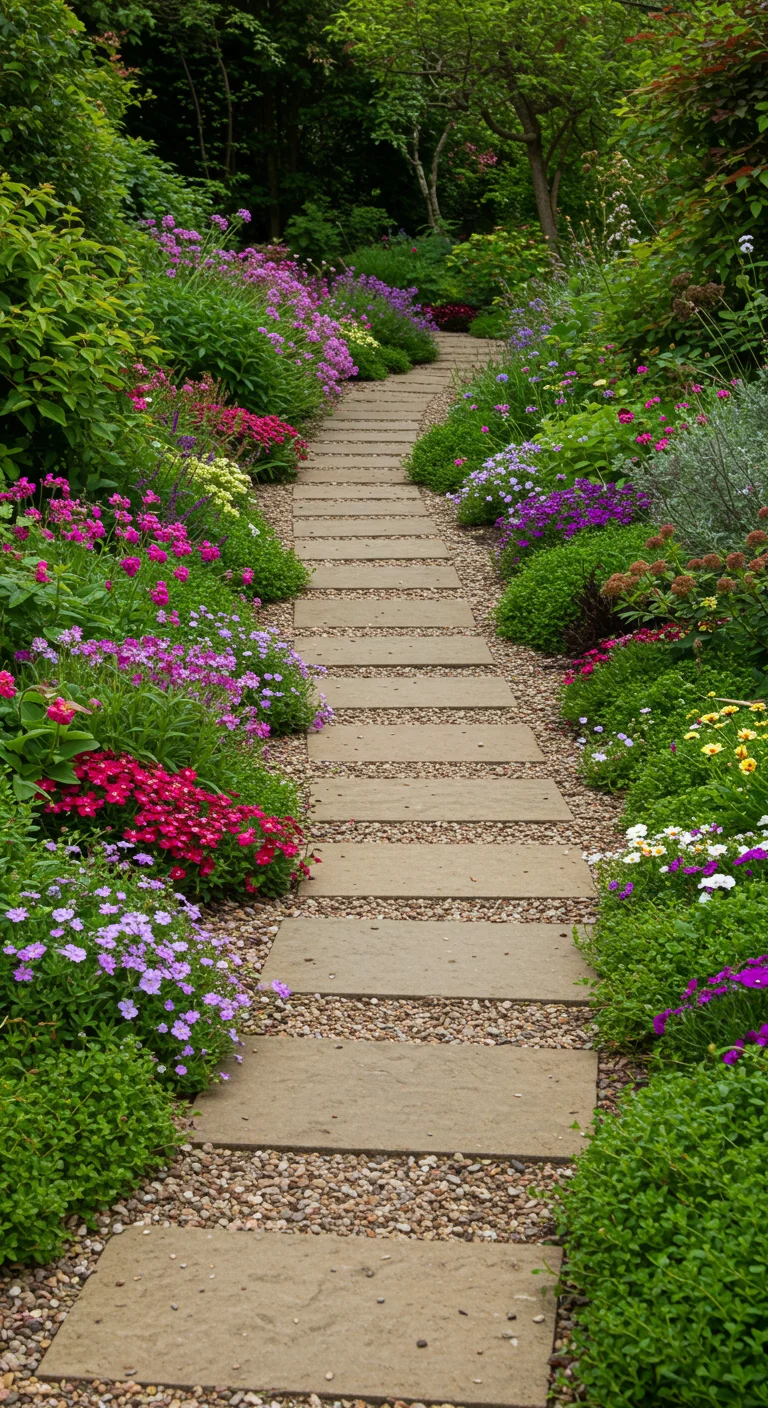
Pathway planting is an innovative approach that seamlessly integrates flora with your garden walkways, enhancing both aesthetics and functionality. To create an inviting and vibrant path, consider using low-growing flowering plants, ground covers, or ornamental grasses that can thrive alongside the walkway. Choose species that can handle foot traffic while adding color and texture to the edges of the path. Incorporating stepping stones or gravel can help delineate the walkway while allowing plants to spill over, creating a lush, natural look. Additionally, consider seasonal plants to ensure year-round interest and color. This method not only beautifies the pathway but also encourages biodiversity by providing habitats for pollinators and beneficial insects.
14. Light It Up: Illuminated Garden Path Ideas
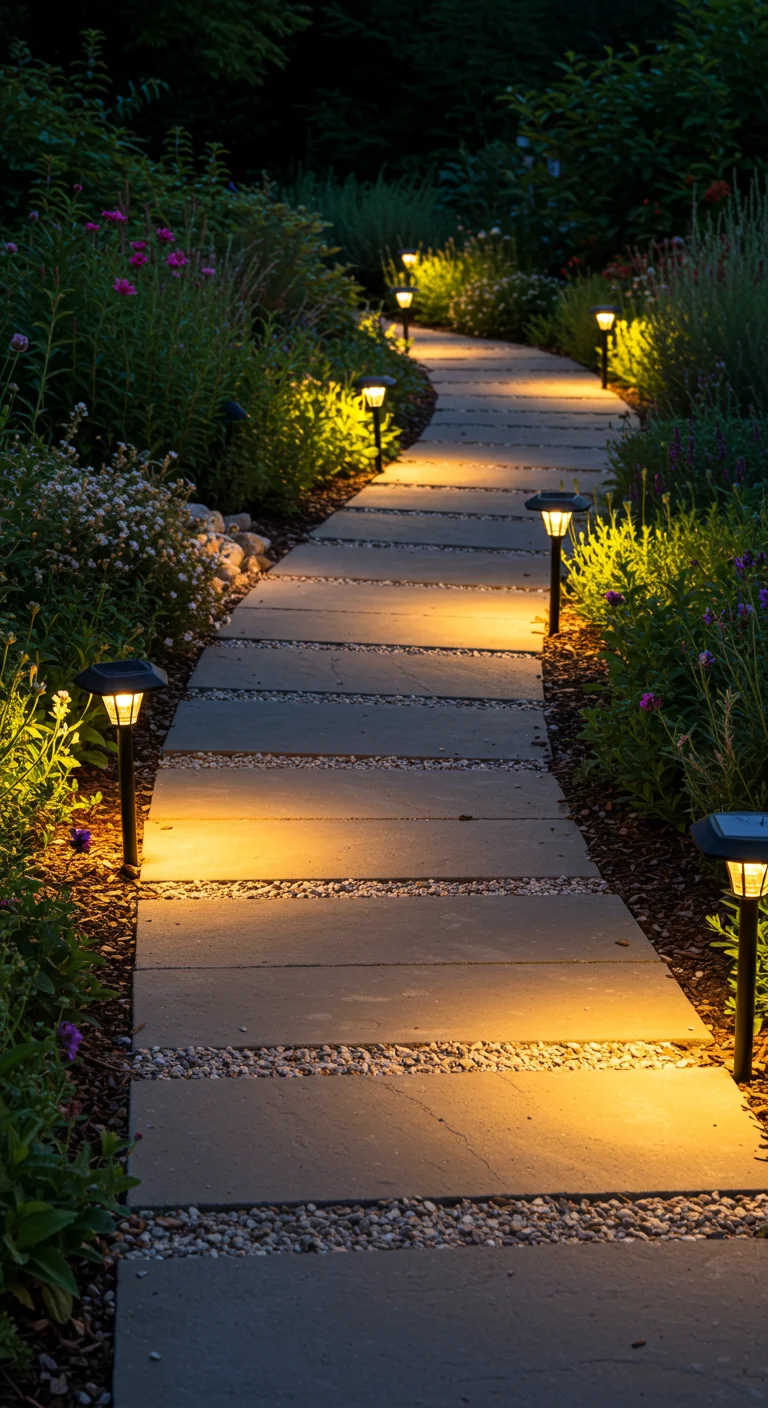
Transform your garden path into a magical journey with illuminated features that enhance both safety and aesthetics. Consider installing solar-powered pathway lights along the edges of your walkway to create a soft glow that guides visitors through your garden at night. You can choose from various styles, including lanterns, fairy lights, or even whimsical, artistic sculptures that double as lighting fixtures. For a more permanent solution, integrate embedded LED lights directly into the path material, such as bricks or stones. Additionally, using up-lighting to shine on surrounding plants or trees can create striking shadows and highlight the natural beauty of your garden. With careful placement and design, illuminated garden paths can significantly enhance nighttime ambiance while ensuring safety and visibility.
15. Curved Paths: Adding Flow and Movement to Your Garden
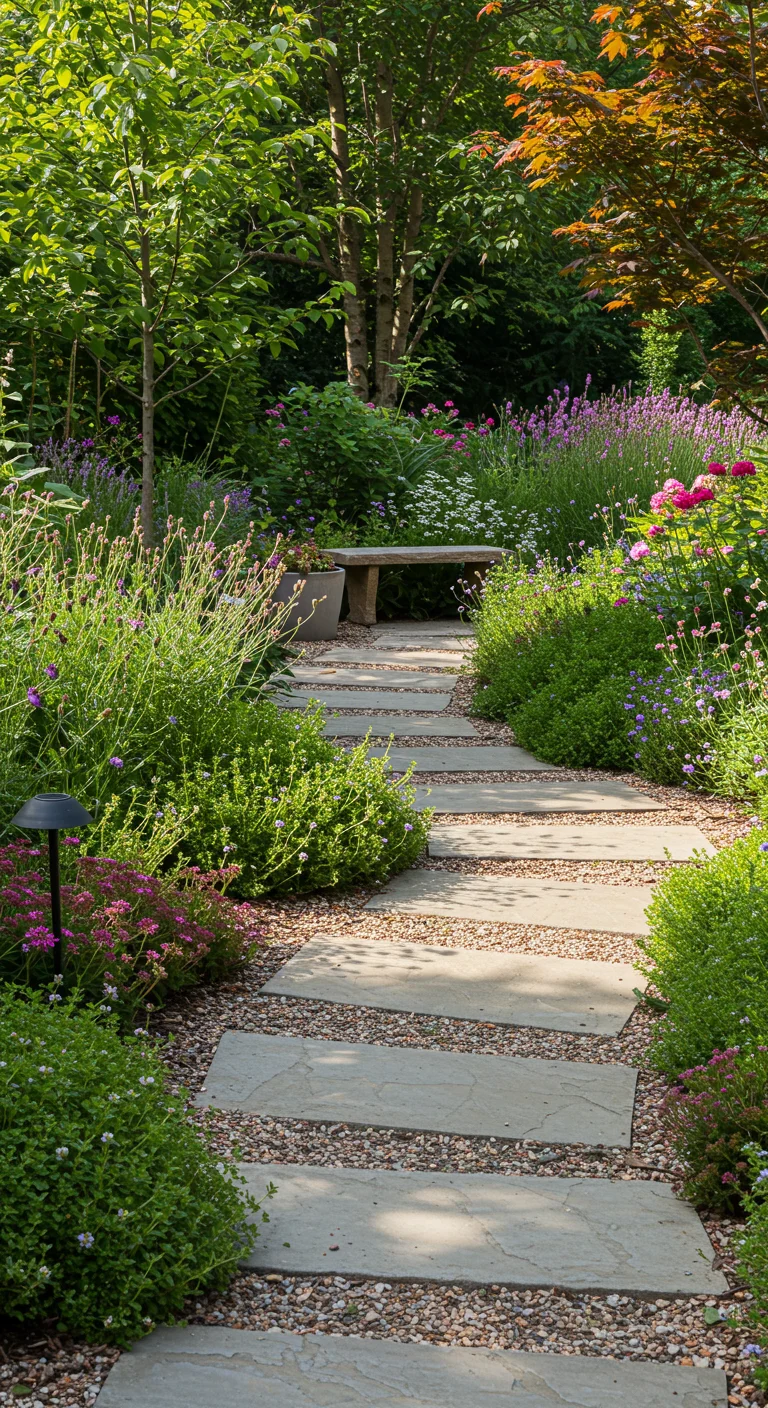
Curved paths can transform any garden into a serene oasis by adding flow and movement to your outdoor space. Instead of rigid, straight lines, consider designing pathways that gently meander through your garden, inviting exploration and enhancing the natural beauty of your plants. Use materials like gravel, mulch, or flagstone to create a soft, organic look that complements your garden’s style. Incorporate low-maintenance edging plants like sedum or creeping thyme along the curves to soften the edges and provide added texture. Additionally, varying the width of your path can create a sense of depth, making the garden feel more expansive. Incorporating gentle slopes or dips in your curved paths can also enhance visual interest, making your garden a delightful place to wander and discover hidden treasures.
16. Stepping Stones: A Fun and Functional Design
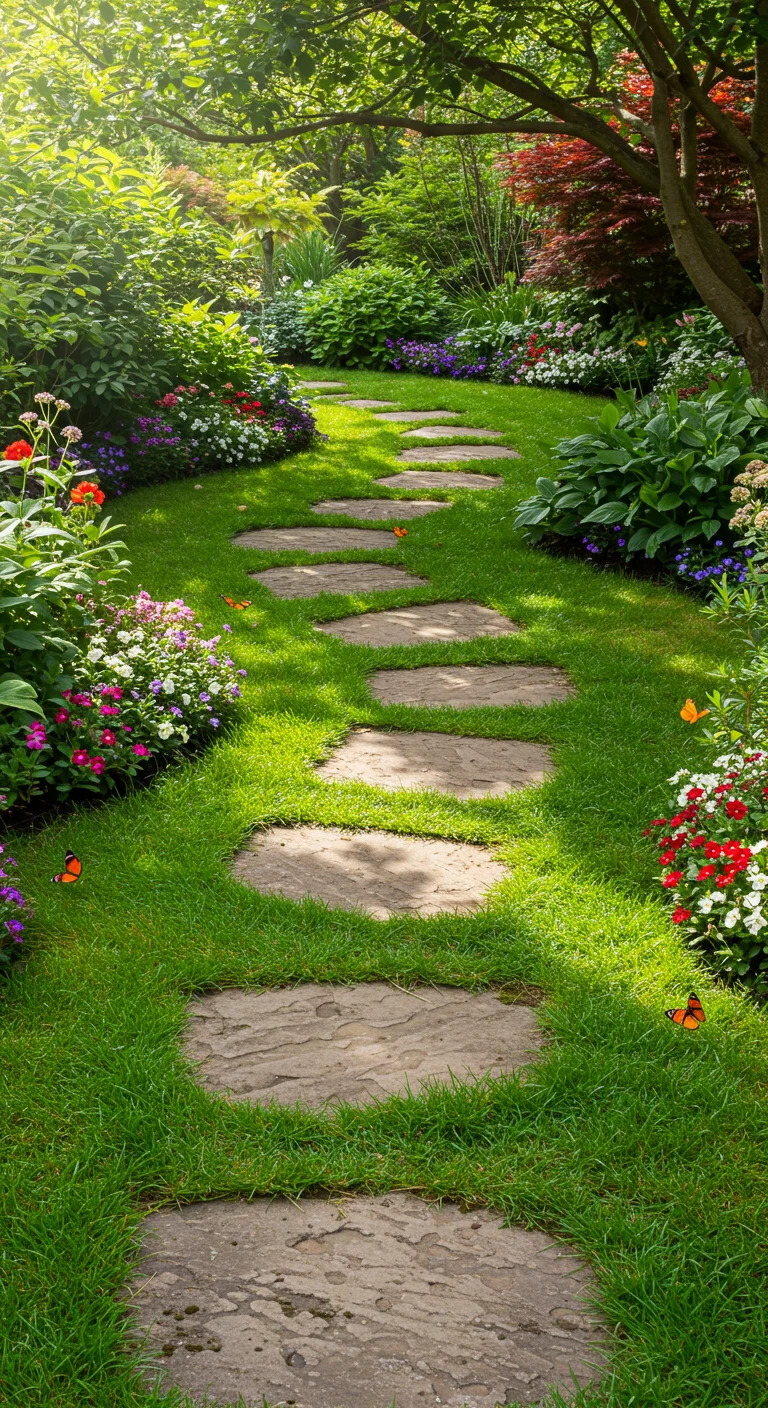
Stepping stones are an excellent choice for creating a visually appealing and functional garden path that blends seamlessly with nature. These stones can be made from various materials like natural stone, concrete, or even recycled materials, allowing for customization to suit your garden’s aesthetic. When designing your path, consider spacing the stones approximately 2 to 3 feet apart, making it easy to navigate while minimizing disruption to the surrounding soil and plants. To enhance the look, you can plant ground cover or low-growing flowers between the stones, creating a lush and inviting atmosphere. Additionally, incorporating different shapes and sizes of stones can add a playful touch, making your garden path not only a practical walkway but also a charming focal point in your outdoor space.
17. DIY Painted Paths: Adding a Splash of Color

DIY painted paths are an innovative way to infuse your garden with vibrant colors while also creating distinct walkways. Start by selecting a durable outdoor paint that can withstand various weather conditions. Use stencils or freehand designs to create unique patterns that reflect your personal style or complement the surrounding flora. For a rustic look, consider using natural stones as a base and painting over them for added visual interest. Ensure to seal your painted path with a weather-resistant clear coat to prolong its lifespan and maintain its brilliance. This colorful path not only guides visitors through your garden but also serves as a delightful visual focal point, making each step a joyful experience in your outdoor space.
18. Vintage Charm: Using Antique Bricks for a Timeless Look
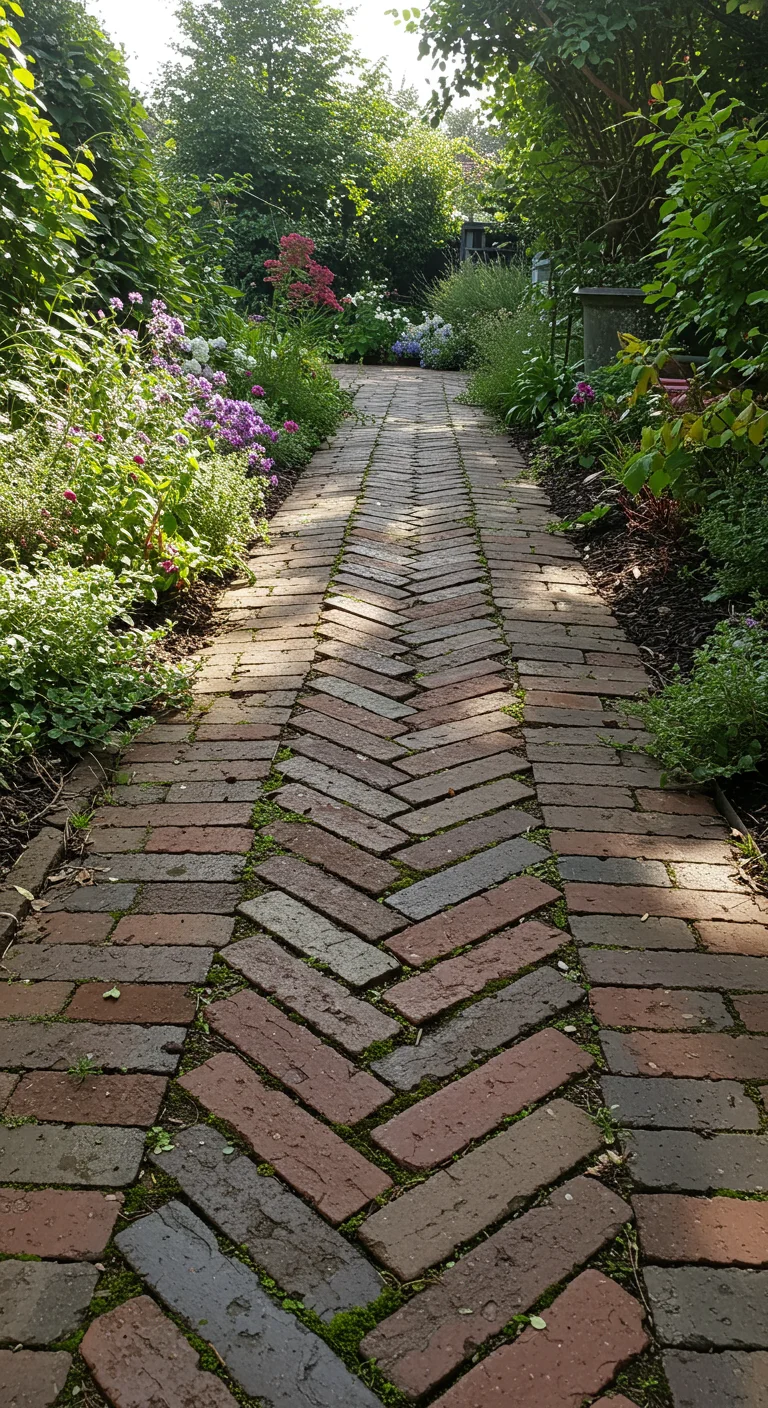
Antique bricks add a unique vintage charm to any garden path, creating a sense of history and warmth. Sourcing reclaimed bricks from local salvage yards or demolition sites not only promotes sustainability but also ensures that each piece has its own story. When laying out your path, consider a herringbone or basketweave pattern to enhance the aesthetic appeal. It’s essential to prepare the ground by leveling the soil and adding a layer of sand for stability. To accentuate the antique look, allow moss or creeping plants to grow between the bricks, softening the edges and integrating the path into the surrounding landscape. This timeless approach not only beautifies your garden but also increases its value by adding character and charm that new materials simply cannot replicate.
19. Vertical Garden Edges: A Unique Pathway Design
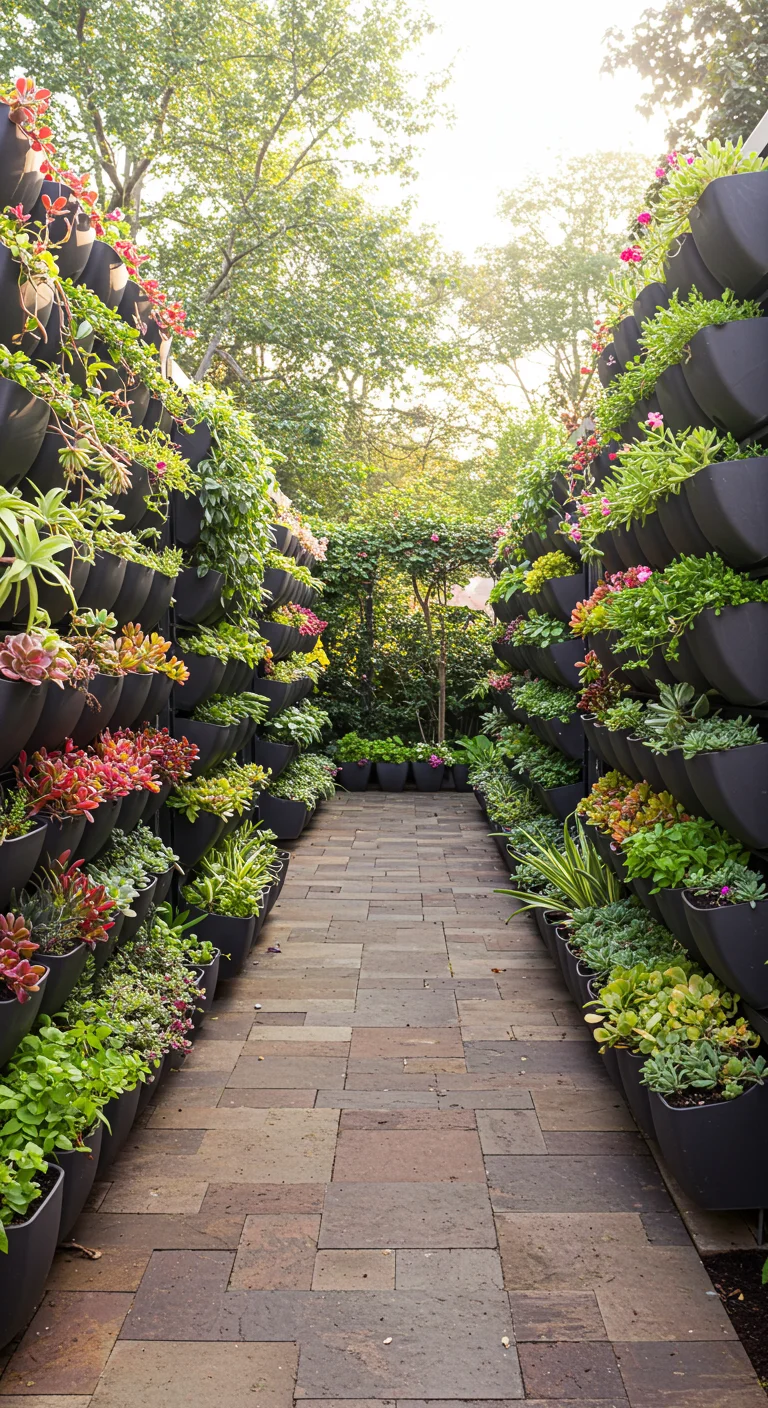
Vertical garden edges are an innovative way to define pathways while adding a lush, green aesthetic to your outdoor space. These garden borders can be created using modular planters filled with a variety of plants such as succulents, ferns, or flowering vines, which not only soften the hardscapes but also provide a vertical dimension that draws the eye upward. To install, simply place the planters along the sides of your path, ensuring they are stable and can hold moisture without becoming waterlogged. This design not only enhances the visual appeal but also helps in creating microclimates for the plants, promoting healthier growth. Ideal for small spaces, vertical garden edges can transform ordinary walkways into enchanting garden corridors, making every stroll a delightful experience.
20. Pathway Borders: Defining Your Garden Pathway
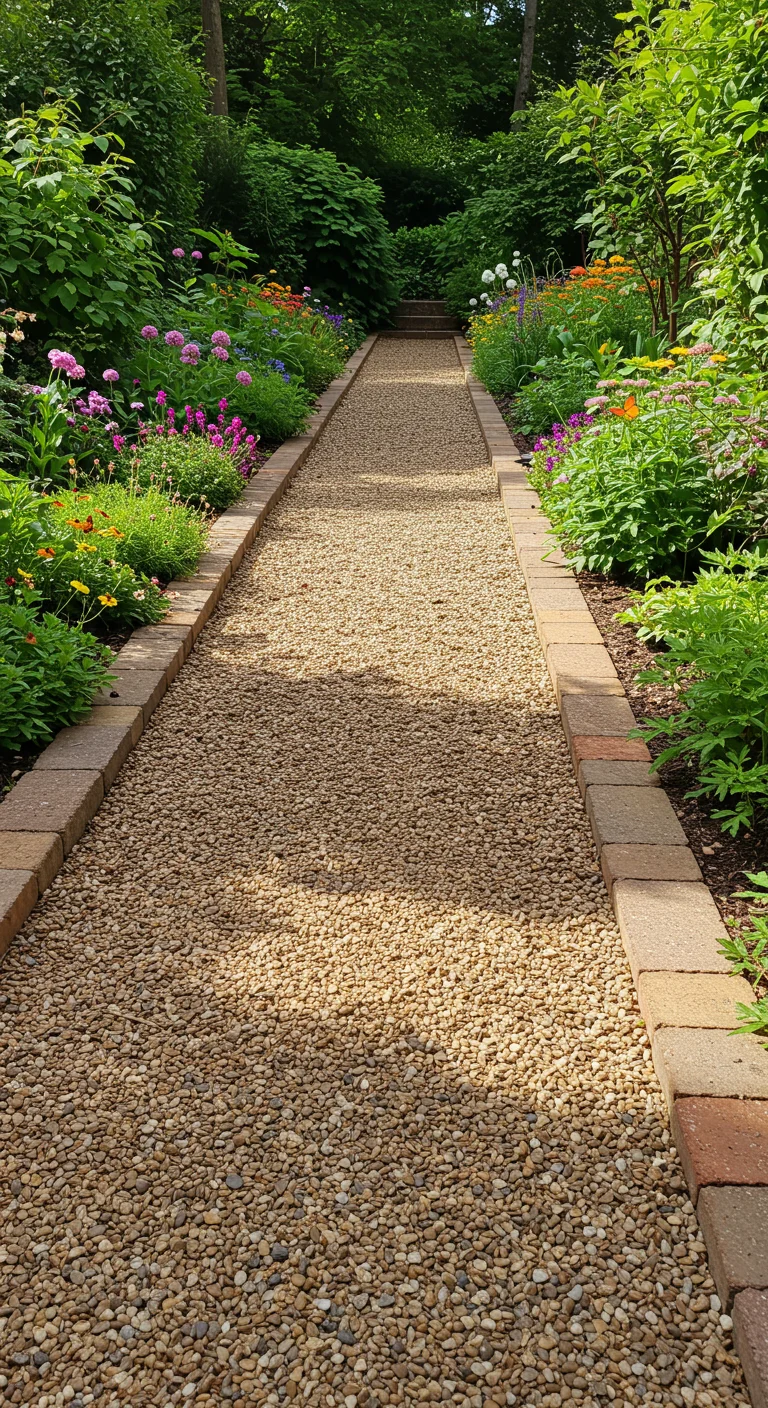
Defining your garden pathway with pathway borders not only enhances the aesthetic appeal but also serves practical purposes such as keeping the pathway materials in place and preventing grass or weeds from encroaching. You can choose from a variety of materials for your borders, including natural stone, bricks, or treated wood. For a rustic look, opt for uneven flagstones or reclaimed wood, while modern gardens may benefit from sleek metal or concrete borders. Ensure that the borders are slightly elevated compared to the path to effectively contain gravel or mulch. Additionally, consider incorporating planting pockets along the borders to add greenery and color, which can soften the look of hard materials and attract pollinators. Overall, well-defined borders create a cohesive look and guide visitors through your garden with ease.
21. Artistic Pathways: Incorporating Personal Touches
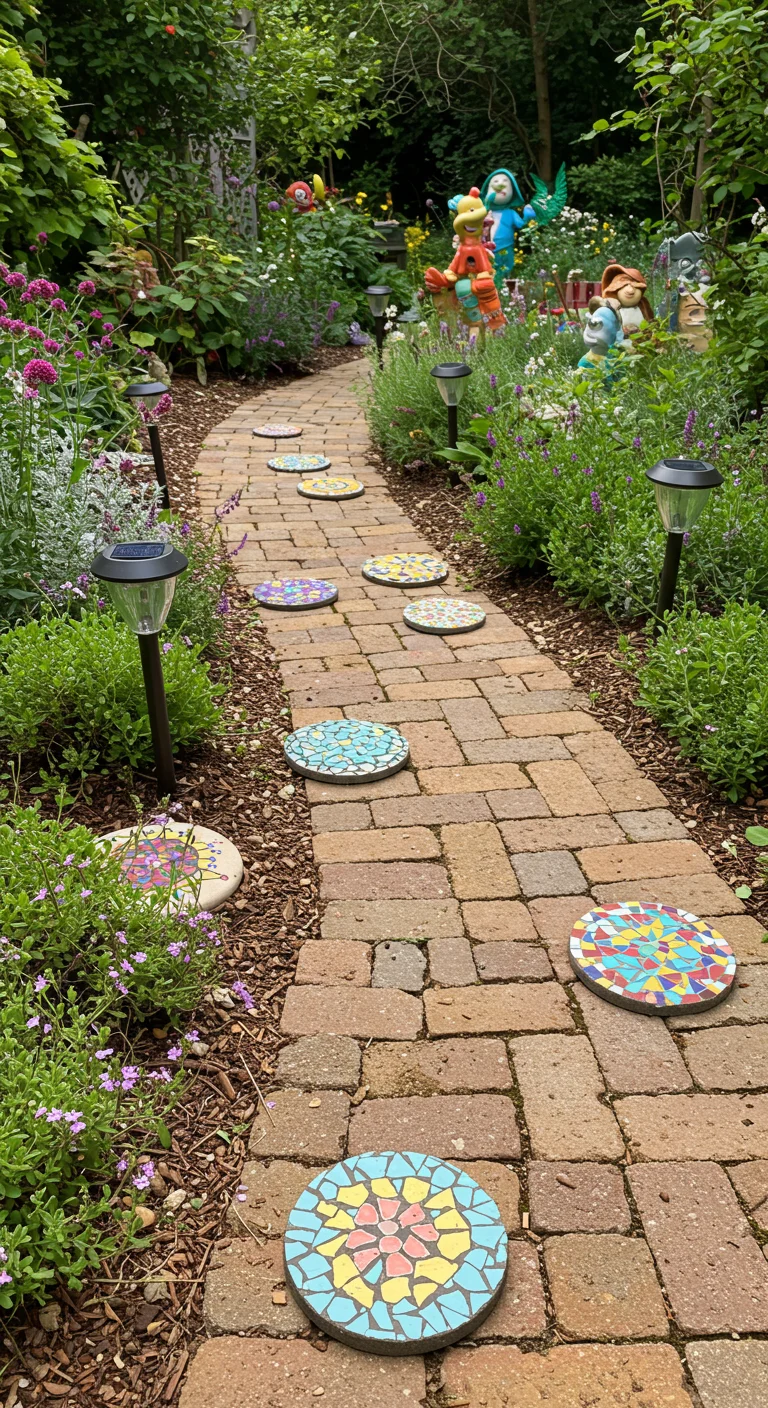
Incorporating personal touches into your DIY garden path can transform a simple walkway into a captivating artistic pathway. Begin by selecting materials that resonate with your style; consider reclaimed bricks, smooth river stones, or colorful tiles. Enhance the path with unique elements like hand-painted stepping stones or mosaic patterns that reflect your personality. Add natural borders with flowering plants or fragrant herbs on either side, creating a sensory experience as you walk. For an interactive touch, install solar-powered garden lights or whimsical sculptures that illuminate the path at night. These personalizations not only enhance the path’s aesthetic appeal but also make it a reflection of your individual creativity and love for gardening.
22. Seasonal Themes: Adapting Your Path for Every Time of Year
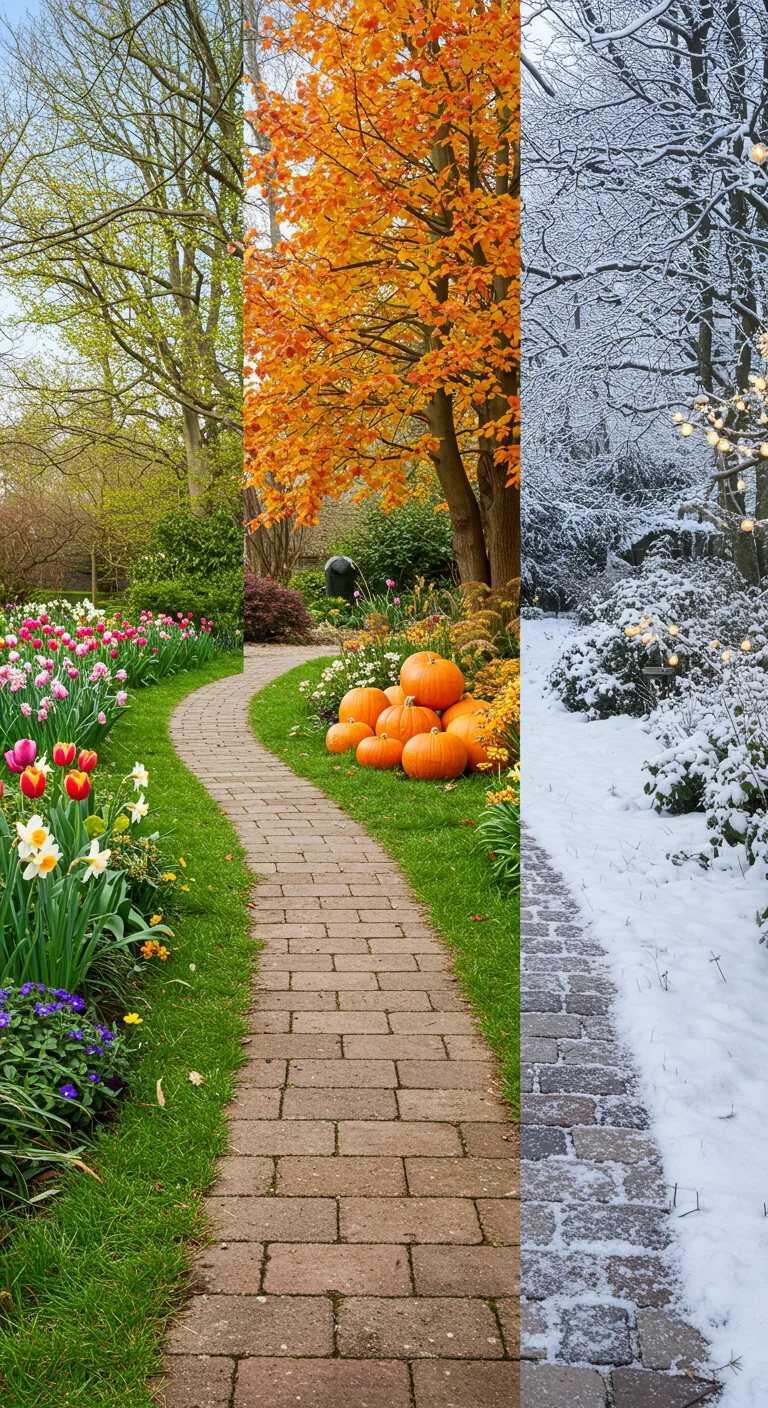
Seasonal themes can transform your garden path into a vibrant showcase throughout the year. In spring, consider incorporating colorful flowering plants along the edges, such as tulips or daffodils, to create a cheerful ambiance. Summer can be enhanced with lush greenery and fragrant herbs like lavender or rosemary, while autumn invites a palette of warm-toned decorations, such as pumpkins or ornamental grasses, to celebrate the harvest. In winter, evergreen plants and twinkling fairy lights can add a magical touch. Utilizing materials like gravel, bricks, or wood can help define the path’s character, making it adaptable for any season. Regularly updating the decor and plant selections in line with the seasons not only keeps your garden path looking fresh but also allows for year-round enjoyment of nature’s beauty.
23. Pet-Friendly Paths: Durable and Safe Options
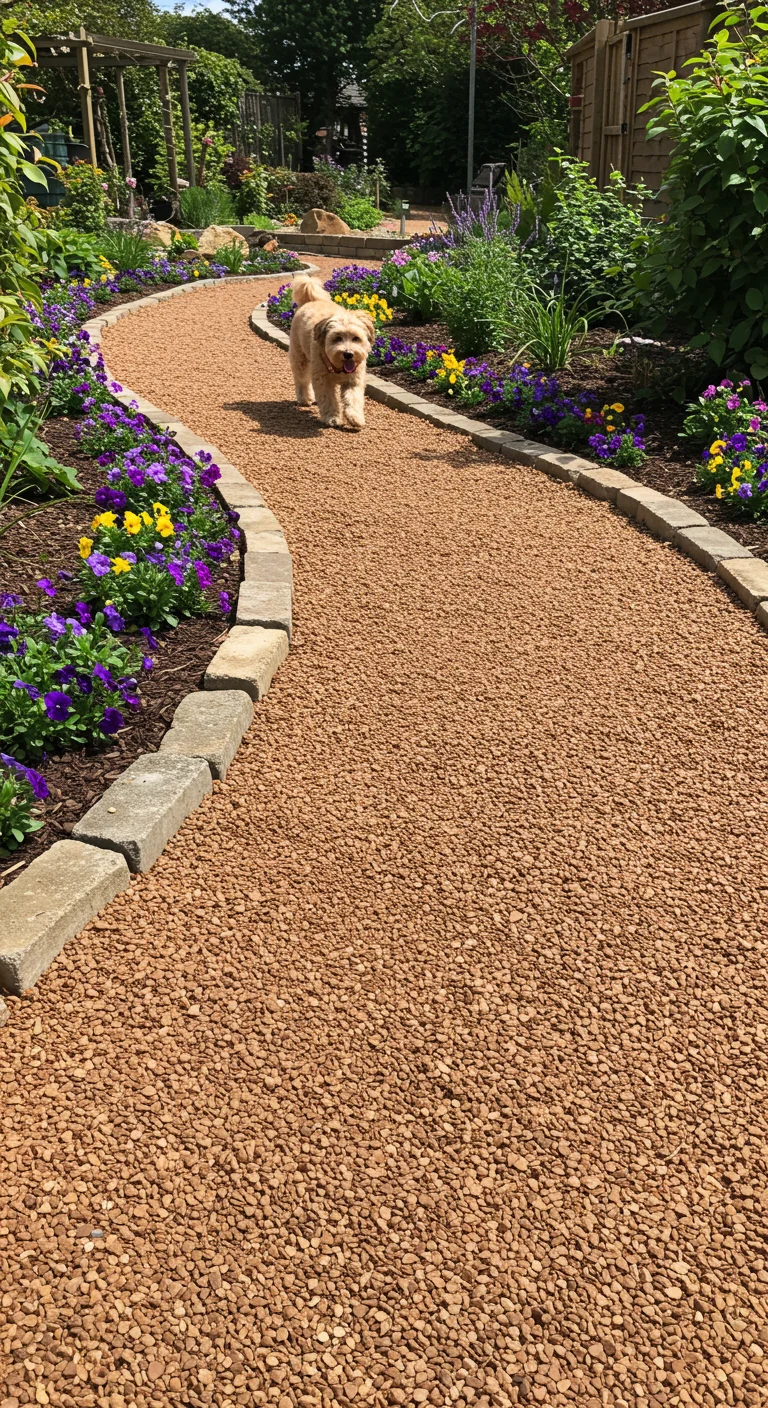
Creating a pet-friendly garden path requires careful consideration of materials and design to ensure durability and safety for your furry friends. Opt for sturdy options like gravel, which offers excellent drainage and is easy on paws, or interlocking pavers that provide a stable, non-slip surface. Incorporating bordered edges with natural stones or treated wood can help define the path while preventing your pets from wandering off. Additionally, consider using non-toxic plants along the path to create a lush environment without harming your pets. To enhance safety, avoid sharp materials and ensure the path is wide enough for your pets to navigate comfortably. Regular maintenance, such as removing debris and checking for wear, will keep your garden path both beautiful and functional for years to come.
24. Water Features: Designing Paths Around Nature’s Beauty
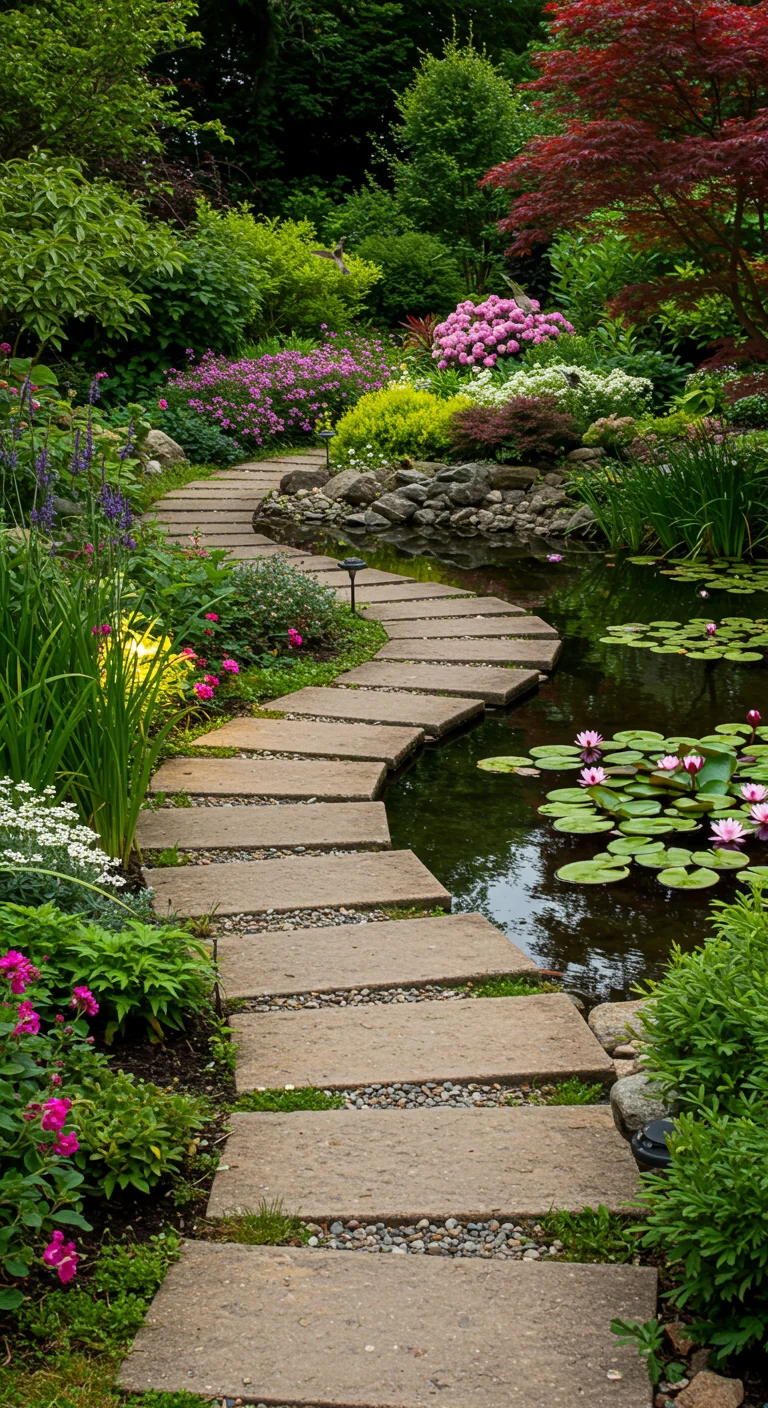
Incorporating water features into your garden path design can create a serene and visually stunning environment that harmonizes with nature. Consider installing a winding path that gracefully weaves around a pond, fountain, or small stream, allowing visitors to enjoy the calming sounds of flowing water. Use natural stones or pebbles to create a rustic pathway that complements the aquatic elements, and plant lush greenery along the sides to enhance the natural feel. Lighting along the path can highlight the water feature at night, adding to the enchanting atmosphere. When designing, ensure the path is wide enough for easy navigation and positioned to offer beautiful views of the water from multiple angles, creating a tranquil retreat in your garden.
25. Budget-Friendly Paths: Stunning Ideas That Won’t Break the Bank
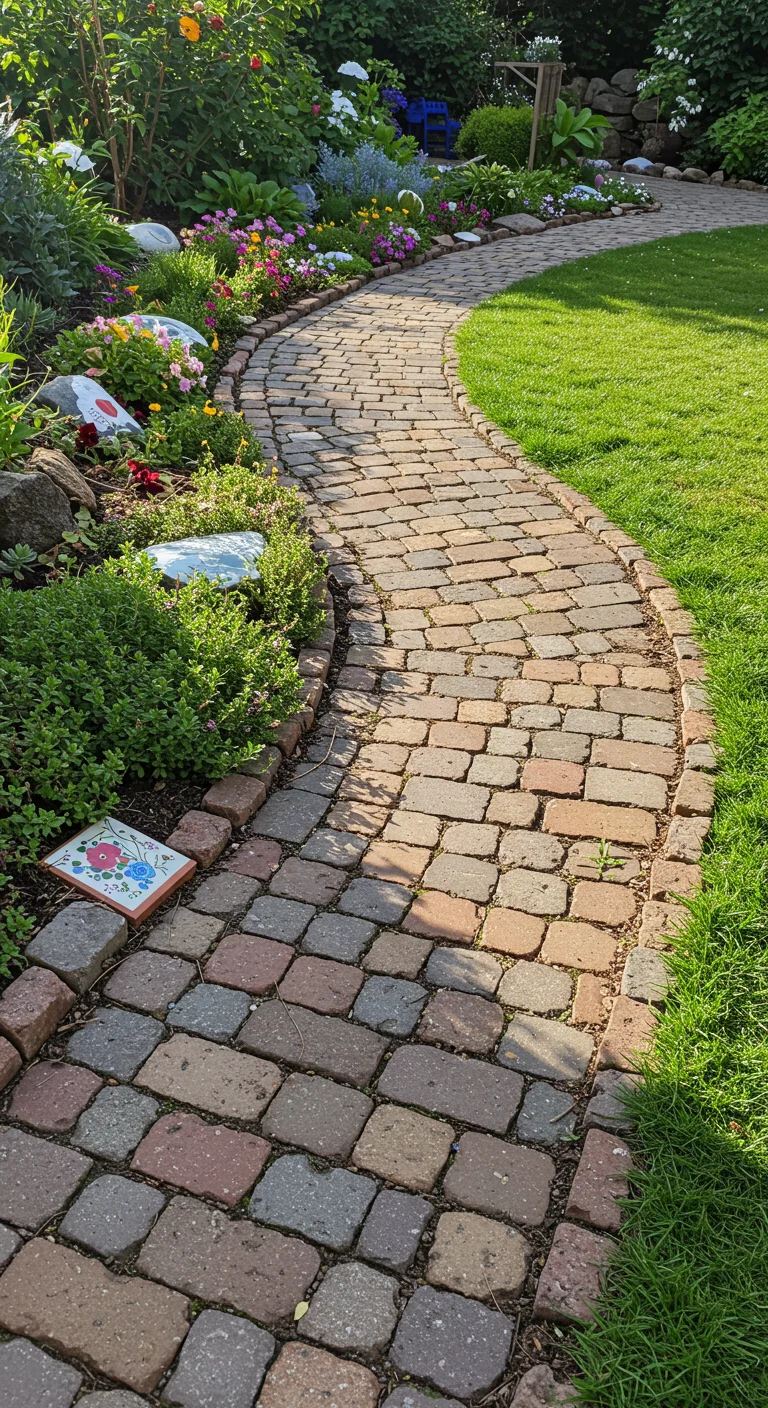
Creating stunning garden paths on a budget is entirely achievable with a little creativity and resourcefulness. Consider using reclaimed materials like old bricks, stones, or wood planks, which can add rustic charm without the hefty price tag. Alternatively, gravel or mulch can provide a cost-effective and easy-to-maintain solution, allowing you to define your path with elegant curves. For a pop of color, incorporate painted stones or repurposed tiles as decorative accents along the edges. Planting low-maintenance ground cover, such as creeping thyme or moss, not only enhances the visual appeal but also helps to stabilize the path. Finally, don’t overlook the power of DIY methods; simple techniques, like using a shovel to outline your path and filling it with your chosen material, can transform your garden without straining your wallet.



